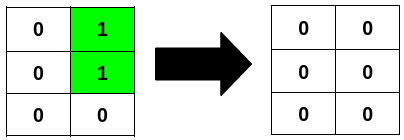Problem
You are given an m x n binary matrix grid.
A row or column is considered palindromic if its values read the same forward and backward.
You can flip any number of cells in grid from 0 to 1, or from 1 to 0.
Return the minimum number of cells that need to be flipped to make all rows and columns palindromic, and the total number of 1’s in grid divisible by 4.
https://leetcode.cn/problems/minimum-number-of-flips-to-make-binary-grid-palindromic-ii/
Example 1:
Input:
grid = [[1,0,0],[0,1,0],[0,0,1]]
Output:3
Explanation:
Example 2:
Input:
grid = [[0,1],[0,1],[0,0]]
Output:2
Explanation:
Example 3:
Input:
grid = [[1],[1]]
Output:2
Explanation:
Constraints:
m == grid.lengthn == grid[i].length1 <= m * n <= 2 * 10⁵0 <= grid[i][j] <= 1
Test Cases
1 | class Solution: |
1 | import pytest |
Thoughts
3239. Minimum Number of Flips to Make Binary Grid Palindromic I 的进阶版。增加的要求除了行和列要同时是回文,还要求 1 的个数能被 4 整除。
翻转后的 grid,相对于中央水平线和垂直线是轴对称的。
对于任意的 0 <= i < m // 2 和 0 <= j < n // 2,都需要 grid[i][j]、grid[i][-j-1]、grid[-i-1][j] 和 grid[-i-1][-j-1] 相等。不同 i、j 对应不同四格组相互独立,所以只要让每个四格组的翻转次数最少即可。如果四个格子的数字两两相同,则需要翻转两次;有一个和另外三个不同,需要翻转一次;四格全相同则不用翻转。(可以对四个格子的值求和,和为 2 则翻转两次,为 1 或 3 则翻转一次,为 0 或 4 则不翻转)。
显然只要四个格子的值相等,他们中 1 的个数要么是 0,要么是 4,都满足能被 4 整除的要求。
需要考虑 4 的整除性的是对于奇数行或奇数列的 grid,正中的那行或列,即下标为 m // 2(m 是奇数)的行或下标为 n // 2(n 是奇数)的列。
首先如果行和列同时是奇数,那么中央位置只有一个格子,其值必需为 0,如果原来是 1,需要翻转一次。
遍历正中行和列每一组对称的双格组,记录两个格子都是 1 的组数,如果是偶数,则 1 的个数能被 4 整除,否则就会余 2。再看一个 0 一个 1 的双格组,如果有,就把第一组里的 0 翻转成 1,跟前边的余 2 加起来正好是 4。剩下的一个 0 一个 1 的双格组,都把 1 翻转成 0。如果没有一个 0 一个 1 的双格组,需要把其边多的两个 1 都翻转成 0。
Code
1 | from typing import List |


